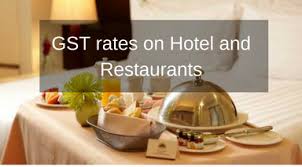 Fooding is one of those business segments which will never go “out of fashion”. According to the National Restaurant Association of India’s 2013 India Food Service Report, the current size of the Indian food service industry is ₹2,47,680 crore and is projected to grow to ₹4,08,040 crore by 2018 at the rate of 11%. Accordingly, this segment has been under the radar of taxation authorities since the inception. Goods and Service Tax (GST) applicability on restaurants has always been the talking point. Businesses are still trying to understand the changes required in their current systems to accommodate the new compliance model. Some of the confusion triggers are:
Fooding is one of those business segments which will never go “out of fashion”. According to the National Restaurant Association of India’s 2013 India Food Service Report, the current size of the Indian food service industry is ₹2,47,680 crore and is projected to grow to ₹4,08,040 crore by 2018 at the rate of 11%. Accordingly, this segment has been under the radar of taxation authorities since the inception. Goods and Service Tax (GST) applicability on restaurants has always been the talking point. Businesses are still trying to understand the changes required in their current systems to accommodate the new compliance model. Some of the confusion triggers are:
- Whether Service Charge is a tax? If not, whether it is compulsory?
- What is the rate of GST applicable for hotels and restaurants?
- Is input tax credit available hotels and restaurants?
- Why is the price not decreasing even when the GST rates have been cut down?
We are looking to decode some of these various confusions here in this article.
Firstly, let us check out what are the components of a bill that is furnished to us by a hotel/restaurant:
- Value Added Tax (VAT) – Erstwhile: This used to be the tax on the food items that you had ordered.
- Service Tax (ST) – Erstwhile: This used to be the tax charged on the services provided by the restaurant/hotel.
- Service Charge: This never was or is a tax. This is a self levied charge by the hotels.
After the implementation of the GST, no separate VAT and ST are now charged. Rather, a consolidated rate is now charged. The rates were shuffled quite a few times. The GST Council, in its 23rd meeting in Guwahati, had slashed the tax rates, made announcements regarding availability of Input Tax Credit.
A summary of latest GST situation has been mentioned below:
Rates:
|
Type of Restaurants/Hotels/Lodges |
GST Rate |
|
All restaurants |
5% no ITC |
|
Restaurants within hotels (room tariff <7,500) |
5% no ITC |
|
Restaurants within hotels (room tariff >7,500 ) |
18% with ITC |
|
Outdoor catering |
18% with ITC |
|
Hotels & Lodges with tariff below Rs. 1000 |
Exempt |
- Liquor will attract state levies like VAT as it was kept outside the GST regime. Service charge might still be levied by the respective restaurant/hotel.
- Food parcels (or takeaways) will also attract 5% GST without ITC.
Input Tax Credit:
The Ministry is of the opinion that since they did not pass on the ITC benefit to customers, the hotels and restaurants will not be eligible for the benefit themselves.
Under the input tax credit, restaurants could claim an offset on the tax they pay on the final products because of the tax they have already paid on input (essentially raw materials). It roughly amounted to 3-4 per cent of the profit.
With the government not allowing the same, some restaurants may now hike prices of the products on the menu itself in a bid to compensate for the losses they are suffering with the lowering of GST rates and withdrawal of input tax credit. Some of such units like McDonalds, Lifestyle have also been sent notices recently.
Impact on Restaurant Business Owners
Example:
On Materials Input:
|
Particulars |
Billing – Erstwhile (Rs.) |
Billing – GST (Rs.) |
|
Rice |
1000 |
1000 |
|
Spices |
300 |
300 |
|
Oil |
200 |
200 |
|
TOTAL |
1500 |
1500 |
|
VAT @ 5% |
75 |
– |
|
GST @ 5% |
– |
75 |
|
|
|
|
Output Billing:
|
Particulars |
Billing – Erstwhile (Rs.) |
Billing – GST (Rs.) |
|
Total Bill |
5000 |
5000 |
|
VAT @ 14.5% |
725 |
– |
|
ST @ 6% |
300 |
– |
|
GST @ 5% |
– |
250 |
|
Total Output Tax Liability |
1025 |
250 |
|
Input Credit – -VAT ITC (from above) |
75 |
– |
|
Final Output Tax Liability – -VAT |
650 |
– |
We have launched Single Platform on GST Compliances In India, assisting in 4 areas – 1) Migration, 2) GST Compliance, 3) Training and 4) Transition & Implementation. Click this link for any assistance.

 Toll Free:
Toll Free:  Contact Us
Contact Us

